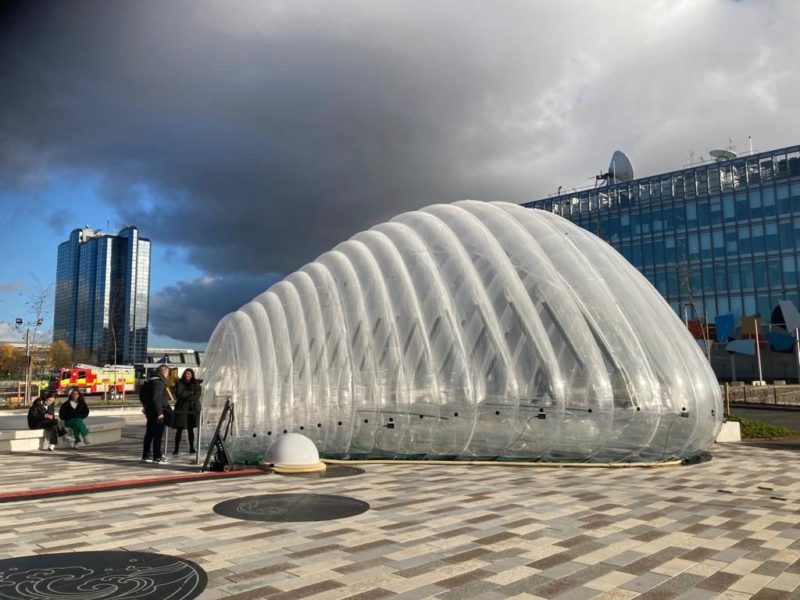Farhad Nadeem Interview: Transcript
Victory: Hi! Can you tell us a bit about who you are, what you are doing at COP, and your thoughts about the event so far?
Farhad Nadeem: My name is Farhad Nadeem. I’m the global brand director for a brand called Otrivin, we’re with GlaxoSmithKline. We’ve brought the Otrivin Air-Bubble to COP as a way to shine a spotlight on how air pollution affects children especially, because children are more vulnerable to air pollutants because their breathing rates are faster and their immunity response is still developing. So they are more vulnerable to pollution, but they’re also the least contributing to it, so we thought it was worth bringing some awareness to it.
And I think the second part of it is, you’ll see behind you there the Otrivin Air-Bubble, it’s an air-purifying installation. It’s also showing what you can do to help children breathe cleaner. So in this case we said, why don’t we build an air-purifier, almost like a playground where children can interact. So that’s why we’re at COP, to shine a spotlight on what air pollution does to children, but also show some tangible actions that you can do to help breathe cleaner.
Victory: That’s great! Could you explain how the Air-Bubble works?
Farhad Nadeem: It’s the second prototype, the first one was built in Warsaw where we had what we call bio-reactors. You see the green tubes over there [in the Air-Bubble], each of them is a bio-reactor and essentially they are comprised of microalgae. This particular microalgae is called Chlorella SP, and what it does is it takes the air and it strips out carbon and other pollutants from the air and it releases oxygen. Through photosynthesis, it essentially converts carbon into oxygen and cleans the air inside.
This one is a second prototype. The one we did in Poland was an actual living breathing playground, 50,000 kids went through it over a 6 month period. We saw a reduction of air pollutants by up to 95%, the average was 80% So inside versus outside, you could see that the air pollution would drop by about 80% inside. We could see that it is promising and there is good data to suggest it, so we are very happy to bring it here and take the conversation forward.
V: Is this something that you would want to implement in other areas as well?
F: I think the first thing I want to do is to inspire people like you; young entrepreneurs, young scientists who might look at this and say “This strikes a particular idea in my head”, and if we can get people’s design or aesthetics, or even we can get them in biology or ecology as a result of it, that’s the first step.
I think the second step would be if schools, urban planners, businesses, if they are interested in scaling this up we’d love to share the technology with them. As an example, we’ve got the BBC Scotland building in front of us, one way you could interpret this is, “What if we did a curtain that is made out of algae and put it all in front of that building?”. And essentially it becomes a gigantic air purifier for the entire building. Nature is awesome and the best way, I think, to combat climate change and its effect on respiratory health especially is to see what nature can teach you and learn from it.
V: Finally, do you have any words for young people to encourage them to find out more about climate change or things they can be doing as in their own lives to combat climate change?
F: I think one thing we’ve encountered, especially with this kind of experiment, is if you bring knowledge, especially science and climate science, in a playful engaging way, children are far more engaged. Beyond what we’ve shared here, my message would be two fold. One would be, don’t think that you’re ever too small to make a difference. We’ve seen people start from very small actions and then they become big actions. But no action is too small.
The second message would be, embrace the science. Make it interesting and playful for yourself.So one example is, you can measure air quality around your house by using these wearable devices and you can actually have a lot of fun in it. There’s one inside right now [in the far end at the back of the Air-Bubble] that actually can measure air quality as you’re walking around every 30 seconds, and it becomes really an interesting way to engage kids. I didn’t know for instance that if I stayed indoors with the windows closed, air quality is actually worse inside than it is outside. So, I suppose playful engagement is how we’d like to talk with children and encourage them to think about solutions.
But also I think children are very inspiring themselves. If we give them the right tools they can take this two steps, ten steps ahead of us.
V: Well thank you so much for talking with us and I hope you enjoy the rest of COP
F: Thank you very much, same to you!


